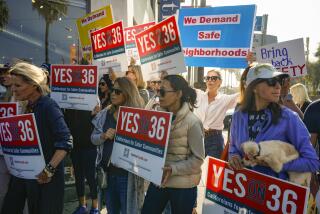Users kicking Prop. 36, not drugs
The most comprehensive assessment of California’s landmark effort to treat drug users rather than jail them has found that nearly half of offenders sentenced under the program fail to complete rehab and more than a quarter never show up for treatment.
The high failure rates have prompted a growing number of critics to call for jail sanctions for defendants they say take advantage of the program’s lack of penalties.
Voters overwhelmingly approved Proposition 36 in November 2000. Under the program, most people convicted of drug possession get three chances to complete rehab and kick their addictions before a judge can send them to prison.
To date, the initiative has cost California more than $600 million. By diverting thousands of nonviolent drug offenders from lockups, the measure has reduced the burden on prisons and saved the state $2.50 for every $1 spent, according to UCLA’s study of Proposition 36.
So far, researchers have analyzed each of the nearly 100,000 defendants who went through the program in its first two years.
But the large number of dropouts and no-shows has led judges, researchers and treatment providers to complain that voters undoubtedly expected more for their money.
“For the lay voter, I’m sure they thought, ‘If you build it they will come,’ and that you would have close to probably a 75% or higher success rate,” said Los Angeles County Superior Court Judge Ana Maria Luna, who leads a county committee on Proposition 36 issues. “We just haven’t seen that anywhere in the state.”
Gov. Arnold Schwarzenegger last year demanded that judges be allowed to jail defendants for short stints if they continue to use drugs or fail to enroll in treatment.
In response, Proposition 36 supporters sued Schwarzenegger and temporarily blocked the governor’s proposal. Now the governor is proposing to cut the program’s funding.
‘Critical juncture’
The stakes are high. For critics, Proposition 36 cannot succeed because it lacks meaningful sanctions to motivate defendants. For supporters, jail terms, however short, would signal a shift away from treating drug use as a health problem and funding cuts would reduce success rates. They argue that to improve the program, the state should spend more to ensure treatment beds are immediately available.
“We’re at a critical juncture,” said Dave Fratello, a Santa Monica-based campaign consultant and one of Proposition 36’s authors. “With every year of declining results, you’ll see reduced funding and hostile changes to the program. It’ll become unrecognizable.”
High failure rates are typical among drug treatment programs, but many judges and law enforcement officials say too few defendants appear to take Proposition 36 seriously.
Indeed, some offenders admit they view the program as a “free pass.”
“Every time I’d get arrested ... [I knew] I’ve got three more chances coming to jail,” Alexander Santillan said in a November interview inside Los Angeles County Jail.
Santillan, 24, was convicted in three drug possession cases and remained free under Proposition 36. He said he treated jail after each new arrest as a chance to recuperate before hitting the streets again.
“When I got out, I just didn’t want to do nothing but get loaded,” he said.
Santillan ran out of chances last year and was sentenced to a year behind bars. He was released early because of jail overcrowding and returned weeks later, accused of car theft. He pleaded no contest and is serving a 16-month prison term.
UCLA researchers, who are evaluating the law as part of a state contract, have recommended that courts better supervise offenders with long rap sheets or move them out of the program.
Their study found that some Proposition 36eligible defendants -- less than 2% -- racked up so many arrests that their costs to the state were 10 times more than the average Proposition 36 defendant.
“Some people, quite frankly, don’t belong in Prop. 36,” Angela Hawken, a UCLA research economist, told state lawmakers last month at a budget hearing. “They’re going to fail. They’re going to keep failing. We’re wasting our money. And we’re really ... putting our community in jeopardy by having them on the streets.”
Last year, the Legislature passed a law allowing judges to jail first-time violators for two days and second-time violators for five days. The changes also gave judges the ability to jail offenders they deem incorrigible for up to 30 days or throw them out of the program.
The move angered supporters of Proposition 36, who said it undermined an initiative that has helped tens of thousands of people beat addiction. UCLA found that 78% of people who completed treatment reported being drug-free one year after their sentence and 59% had found jobs.
“Most people in recovery will have a relapse.... Isn’t California fed up with our prisons being overcrowded?” said Dr. David Pating, president of the California Society of Addiction Medicine.
The group, along with others, has sued Schwarzenegger and the state, arguing that attempts to roll back the program must be put to a statewide vote.
In September, they won an injunction to stop the Legislature’s changes from taking effect. The case is expected to be heard this year.
From the start, Proposition 36 faced overwhelming challenges.
The initiative gave most nonviolent offenders convicted of drug possession the option to enter treatment rather than jail or prison. Since it started in July 2001, about 50,000 people have entered the program each year. Half had never received treatment.
But the severity of their addictions took the measure’s authors by surprise. More than half of the defendants reported using drugs for longer than a decade, according to evaluations by UCLA researchers. Some had spent lifetimes in and out of prison.
Matthew Abplanalp was born addicted to drugs. As a child, he bounced between foster homes. At 9, he smoked pot for the first time. Now 37, Abplanalp has spent most of the last two decades behind bars for stealing and using drugs.
Two years ago, he was arrested on fresh drug charges and sentenced under Proposition 36. Although he enrolled in treatment, he didn’t stay drug-free. After multiple relapses, he was ordered back to rehab. He was using drugs again in August when he turned himself in to police.
“I am grateful for it,” he said of the initiative, sitting in the Tarzana Treatment Center, where he said he has stayed clean for six months. “The only other solution would be to put me in jail, and that’s proven not to work for me.”
By diverting offenders like Abplanalp into rehab, Proposition 36 has reduced the number of prisoners at any time serving sentences for drug possession by more than 4,000, from nearly 19,000 when it began in 2001.
Yet, while fewer offenders are sentenced to long prison and jail terms, law enforcement officials complain that they are busier than ever arresting drug users. Many have outstanding warrants for violating Proposition 36.
Courts have little choice but to release them unless they have exhausted their three chances. A Times analysis of Los Angeles County jail data found that drug possession bookings soared 150% between 2000, the year before Proposition 36 began, and 2005.
Drug counselors, judges and county officials say the program desperately needs more money. The ballot measure set aside $120 million a year for the first five years, yet defendants often wait weeks, sometimes months, before a residential treatment bed is available.
Less costly outpatient treatment is more readily available but has proven largely ineffective with long-term abusers.
“If you can’t strike while the iron’s hot, you’re going to lose many of them back to the street,” said Al Senella, chief operating officer at Tarzana Treatment Center and president of the California Assn. of Alcohol and Drug Program Executives.
The measure’s authors acknowledge that they did not include enough money.
Funding squeeze
Last year, Schwarzenegger renewed funding for the initiative and added $25 million to state funds on the condition that legislators give judges the ability to order some offenders into jail.
But the governor’s latest budget axes $25 million and requires counties to contribute money.
His office said he remains committed to closing what spokeswoman Sabrina Lockhart called a “gaping loophole” that has allowed Proposition 36 defendants to slip through the cracks.
“Voters wanted first-time nonviolent offenders to get treatment, not jail time,” she said. “If they’re not getting treatment, then the governor believes that appropriate sanctions would include incarceration.”
But proponents of drug treatment worry that a squeeze on funding could lead to worse results, which would in turn lead to a cycle of more cuts. An association of county drug administrators has said at least $209 million a year is needed to fully fund treatment statewide.
“We are a national model for this approach to nonviolent drug offenses,” said Margaret Dooley, a spokeswoman for the Drug Policy Alliance, which opposes the governor’s attempts to alter Proposition 36.
“If we do not have the commitment to make it succeed, that says a lot more about us than this program.”
megan.garvey@latimes.com
*
(BEGIN TEXT OF INFOBOX)
Report card
During the first two years of California’s Proposition 36, more than a quarter of those ordered into rehab never showed up for treatment, and fewer than a quarter completed the treatment. These are the latest complete numbers released by UCLA researchers evaluating the program.
---
Participants and treatment rates
---
2001-02 (July 1 to June 30)
Ordered to rehab: 44,043
Didn’t show up: 30.8%
Didn’t complete: 45.4%
Completed: 23.8%
---
2002-03 (July 1 to June 30)
Ordered to rehab: 50,335
Didn’t show up: 28.6%
Didn’t complete: 46.9%
Completed: 24.5%
---
Prison inmates serving time for drug possession
(As of end of June and end of December)
[Please see microfilm for bar chart information]
---
Note: Proposition 36 went into effect July 1, 2001.
Sources: California Department of Alcohol and Drug Programs, UCLA, California Department of Corrections and Rehabilitation
More to Read
Sign up for Essential California
The most important California stories and recommendations in your inbox every morning.
You may occasionally receive promotional content from the Los Angeles Times.












